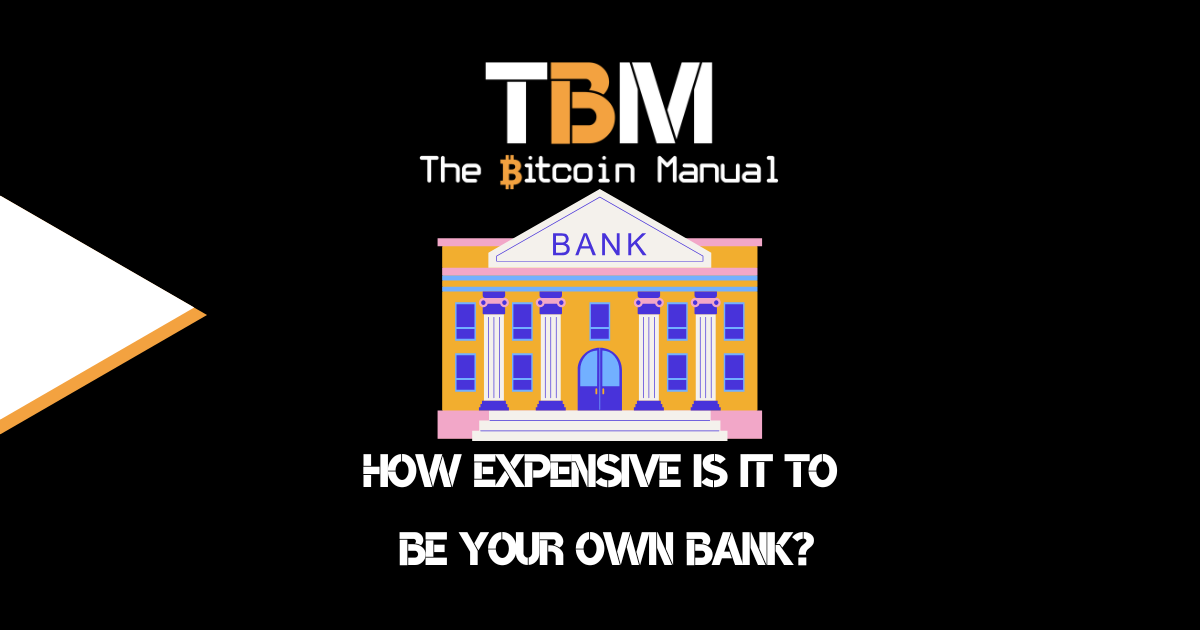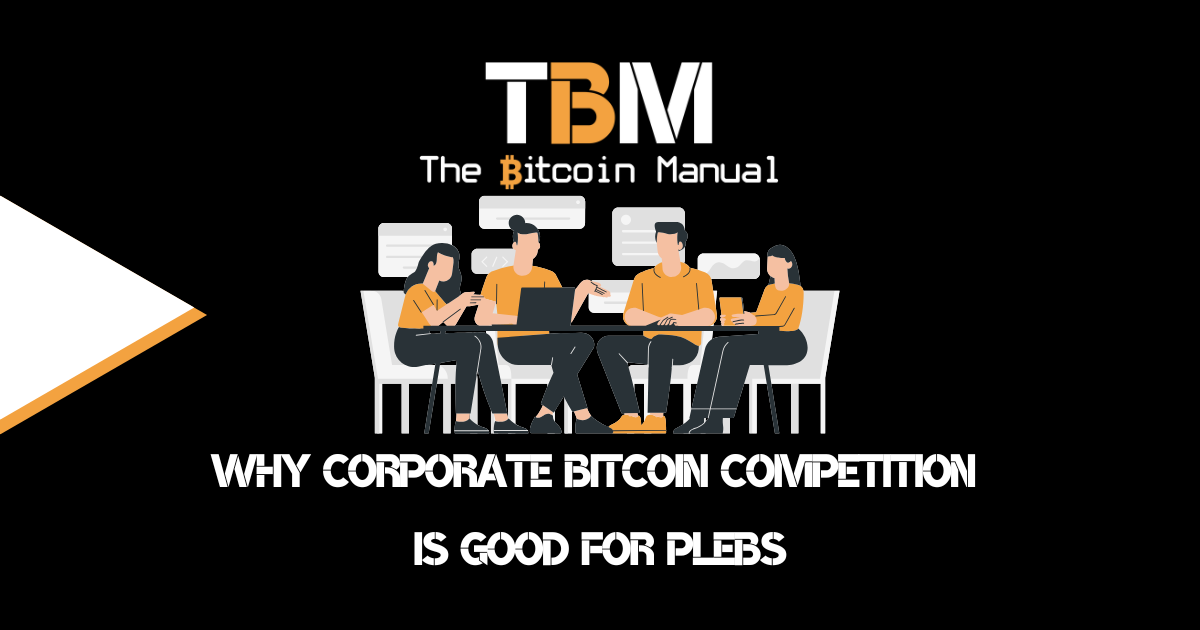Every month, millions of people quietly hand over their hard-earned money to banks through fees that have become so normalised we barely notice them.
Account maintenance fees, overdraft charges, ATM surcharges, wire transfer costs—these seemingly small amounts compound into substantial sums over time.
Meanwhile, the infrastructure to become your own bank through Bitcoin has never been more accessible or affordable.
The calculations might surprise you.
At least it did for me; as a stingy pleb looking to maximise my savings, I’ve been pretty surgical about trimming my spending and optimising where I can, but banking fees have been one I’ve ignored for the longest time.
The Real Cost of Traditional Banking
With all the subscription services we pay for today and complain about, one that we often overlook is the subscription service to our money.
If I consider my banking fees, I pay roughly R500 ($28) in fees per month, which include:
- Fees for a chequing account
- Fees for a credit card
- Insurance on the credit card
- Fees for certain transactions
According to reports, I net the bank more than the average fee of R260 ($14.50) per month.
These figures serve as a starting point; I am by no means a power user of banking services, which highlights the sobering reality of what traditional banking costs.
Note: I am using my local figures; plug in your country’s (South Africa) banking fees and let me know if it’s better or worse in your part of the world, and drop it in the comments
Bank monthly fees can range from $15 to $40, depending on accounts, which often charge even more. But monthly maintenance fees are just the beginning of your banking expenses.
Overdraft fees average around $30.82 per occurrence, according to recent surveys, with some banks charging up to $70 (for an initiation fee plus a monthly fee to keep the service active). For many consumers, overdraft fees aren’t rare occurrences—they’re regular monthly expenses.
A person who overdrafts twice per month face an additional $60+ in fees beyond their maintenance charges.
Then there are the countless other fees that nickel and dime customers: out-of-network ATM fees (typically $1-4 per transaction), wire transfer fees ($15-50 per transfer), foreign transaction fees (2-3% of purchase amount), cashier’s check fees ($8-15), and stop payment fees ($25-35). For business owners, the costs multiply with higher maintenance fees, transaction limits, and processing charges.
Let’s consider a moderate banking customer who pays $15 monthly maintenance, experiences two overdrafts per month, uses out-of-network ATMs twice monthly, and sends one domestic wire transfer quarterly.
Their annual banking costs would be:
- Monthly maintenance: $180
- Overdraft fees: $720
- ATM fees: $96
- Wire transfers: $120
- Total: $1,116 per year
For many people, especially those with less predictable cash flow, these costs run significantly higher.
Banks are not only milking the average consumer; business owners can incur $1,000 annually in banking fees, while international transactions can push costs even higher, with additional clearing fees from SWIFT and foreign exchange conversion fees.
Let’s not even mention the fees from third parties, such as PayPal, should you run your business using multiple payment providers.
Oh, and remember, banking fees only increase over time; they don’t decrease.
| Bank | Cost 2019 | Cost 2024 | Change |
|---|---|---|---|
| Standard Bank | R200 | R266 | +R66 (33.0%) |
| Absa | R220 | R278 | +R58 (26.4%) |
| FNB | R238 | R246 | +R8 (3.4%) |
| Nedbank | R230 | R240 | +R10 (4.3%) |
| Average | R222.00 | R257.50 | R35.50 (6.1%) |
The One-Time Investment in Financial Sovereignty
Contrast these recurring banking costs with the one-time investment required to become your own bank through Bitcoin infrastructure.
The three core components you need are surprisingly affordable:
Bitcoin Hardware Wallet: $60-200
A hardware wallet like the Ledger Nano X ($159) or Trezor Model T ($129) provides secure storage for your Bitcoin. These devices offer bank-grade security without monthly fees, subscription costs, or maintenance charges. Your one-time purchase provides years of secure storage with no ongoing costs.
Even premium options like the Foundation Envoy ($199), Coldcard Mk4 ($180) or BitBox02 ($280) cost less than many people pay in banking fees within three months. These devices are designed to last for years, making them exceptional value propositions compared to recurring monthly banking charges.
If you’re strapped for cash or don’t want to spend much on a signing device, budget options are also available, such as the Ledger Nano S and Blockstream Jade, which can be purchased for around $80-$90.
Bitcoin Full Node: $200-800
Running your own Bitcoin node ensures complete financial sovereignty—you don’t rely on third parties to validate transactions or maintain your balance information.
While you can run a node on an existing computer, dedicated hardware provides better performance and reliability.
Popular options include:
- Raspberry Pi 4 setup with external storage: $200-300
- Purpose-built nodes like Start9 Embassy: $599 – R899
- Umbrel Home: $315
- Custom builds with mini-PCs: $300-500
A Bitcoin node validates all transactions on the network, ensuring you’re never dependent on banks or third-party services to confirm your financial reality. This infrastructure runs 24/7, providing the backbone for true financial independence.
Lightning Network Channel: $3 – $50 fee
Opening Lightning Network channels requires an initial Bitcoin deposit that remains yours—it’s not a fee but rather your own money allocated for instant, low-cost transactions.
You might start with $100-200 in Lightning channels, which enables thousands of small transactions with fees measured in pennies rather than dollars.
You’ll pay the standard fee to perform a Bitcoin transaction as a one-time payment and have to commit funds to that channel. However, those are active funds that you can use for your purchases, not funds you’re handing over to a service provider.
Lightning channels are your personal payment rails, allowing instant Bitcoin transactions with fees typically under $0.01. Unlike banking infrastructure that charges you to use their rails, Lightning channels use your own Bitcoin to facilitate payments directly between parties.
Total Infrastructure Cost: $310-1,300
For a complete Bitcoin banking setup, you’re looking at roughly $310-1,300 in one-time costs.
Let’s use $600 as a reasonable middle estimate for quality equipment that will serve you for years.
The Mathematics of Financial Freedom
The contrast is striking.
Our moderate banking customer paying $1,116 annually in fees would recover their entire Bitcoin infrastructure investment in just 6.5 months.
After that, their ongoing costs drop to essentially zero—just electricity for running a node (roughly $20-40 annually) and occasional Lightning channel management.
Over five years, the financial difference is dramatic:
Traditional Banking (5 years):
- Monthly fees, overdrafts, ATM charges, wire transfers: $5,580
- Plus inflation adjustments on fees: ~$6,200 total
Bitcoin Self-Banking (5 years):
- Initial infrastructure: $600
- Electricity costs: $150
- Total: $750
Five-year savings: $5,450
For business owners with higher banking costs, the savings multiply accordingly. A business paying $3,000 annually in banking fees would save over $14,000 in five years while gaining complete financial sovereignty.
Beyond the Numbers: The Value of Sovereignty
The financial savings, while compelling, represent only part of the value proposition.
Traditional banking subjects you to:
- Account freezes and holds without your consent
- Transaction monitoring and reporting to government agencies
- Limits on how much you can withdraw or transfer
- Geographic restrictions on accessing your money
- Third-party risk if your bank fails or faces liquidity issues
- Inflation eroding the value of deposits earning minimal interest
Bitcoin self-custody eliminates these concerns entirely. Your money remains under your exclusive control, accessible 24/7 from anywhere in the world. No institution can freeze your funds, limit your transactions, or require permission for you to access your own money.
Lightning Network channels enable instant, global payments without intermediaries.
You can send $5 or $5,000 to anyone worldwide in seconds, paying fractions of a cent in fees. Try doing that through traditional banking for less than $50 in charges and days of processing time.
Addressing Common Concerns
“What about FDIC insurance?”
While banks offer FDIC protection up to $250,000, this insurance comes at the cost of monetary debasement through inflation. Your dollars are “safe” but constantly losing purchasing power. Bitcoin, while volatile, has appreciated dramatically over time, providing better long-term wealth preservation than dollar deposits.
“Isn’t Bitcoin too complicated?”
Modern Bitcoin tools have become remarkably user-friendly. Hardware wallets offer simple interfaces, and node software like Umbrel provides point-and-click setup. The initial learning curve is comparable to setting up online banking—except you’re learning skills that provide lifetime financial sovereignty rather than dependence.
“What if I lose my hardware wallet?”
Hardware wallets use recovery seeds that restore access to your Bitcoin even if the device is lost or damaged. This is actually more secure than traditional banking, where account closure or bank failure can create significant access challenges.
“Where can I spend my Bitcoin?”
I realise this isn’t a totally like-for-like comparison when it comes to the medium of exchange; while banks are costly, their payment rails are convenient. You can show up anywhere and tap or swipe your card, and you can be pretty sure the transaction will go through.
Additionally, you can even pay without having cash on hand since banks are willing to extend credit.
With Bitcoin, you’ll have to look for select stores and payment providers or swap out vouchers and gift cards if you want to use it directly or trade it for cash using a Bitcoin ATM or P2P trade.
This can be a pain, and what you save in fees with the bank, you’ll have to pay for in a few inconveniences to spend your Satoshis, for now.
As Bitcoin adoption grows, circular economies emerge, and retailers see the value in accommodating the payment option, the barriers surrounding the medium of exchange will only drop over time.
The Long-Term Perspective
Banking fees compound relentlessly. That $1,116 annual cost grows with inflation, new fee categories, and changing bank policies you cannot control. Over a 20-year period, moderate banking customers typically pay $25,000-40,000 in various fees—enough to purchase a car or make a substantial investment.
Bitcoin infrastructure, by contrast, becomes more valuable over time. Your node contributes to network security while providing personal financial verification. Your Lightning channels enable participation in the growing Bitcoin economy. Your hardware wallet secures not just current holdings but unlimited future wealth.
The network effect amplifies these benefits. As more individuals and businesses adopt Bitcoin, your infrastructure becomes increasingly valuable.
You’re not just saving money—you’re positioning yourself within the financial system of the future.
Making the Transition
You don’t need to abandon traditional banking overnight. Many people begin by:
- Starting small: Purchase a hardware wallet and begin learning Bitcoin custody
- Running a node: Set up Bitcoin infrastructure while maintaining bank accounts
- Opening Lightning channels: Experiment with instant, low-cost payments
- Gradual transition: Slowly move more financial activity to Bitcoin rails
Each step reduces dependence on traditional banking while building expertise in sovereign finance. The infrastructure investment pays for itself quickly while providing skills and capabilities that compound over time.
The Opportunity Cost of Inaction
Every month, your delay represents a continued wealth transfer to banking institutions. Those overdraft fees, maintenance charges, and transaction costs don’t pause while you consider alternatives. They accumulate relentlessly, funded by your labour and productivity.
So, as you move more of your activity over to the Bitcoin network, you can save on many of the punitive fees that banks are charging you. Those fees saved can be stored as satoshis that also increase in purchasing power over time, so you’re being rewarded for de-banking yourself and self-banking.
The opportunity cost extends beyond direct fees. Money paid to banks cannot be invested, saved, or used productively. It’s economic value extracted from your life to support financial intermediaries who provide decreasing value in an increasingly digital world.
Don’t Trust, Let The Math Speak for Itself
The numbers don’t lie.
Traditional banking costs far more than building your own Bitcoin infrastructure, while providing far less financial sovereignty and security. For the cost of 6-12 months of typical banking fees, you can establish financial infrastructure that serves you for decades without ongoing charges.
This isn’t just about saving money—it’s about reclaiming financial autonomy in an age of increasing monetary surveillance and control. Every dollar not paid in banking fees is a dollar that remains under your control, growing in value within a system designed to preserve rather than extract wealth.
The infrastructure exists today. The tools are mature and accessible. The only question is whether you’ll continue paying banks for the privilege of using your own money or invest in becoming your own bank with complete control over your financial future.
The choice is yours, but the math makes it clear: being your own bank isn’t just financially smart—it’s financially essential.




